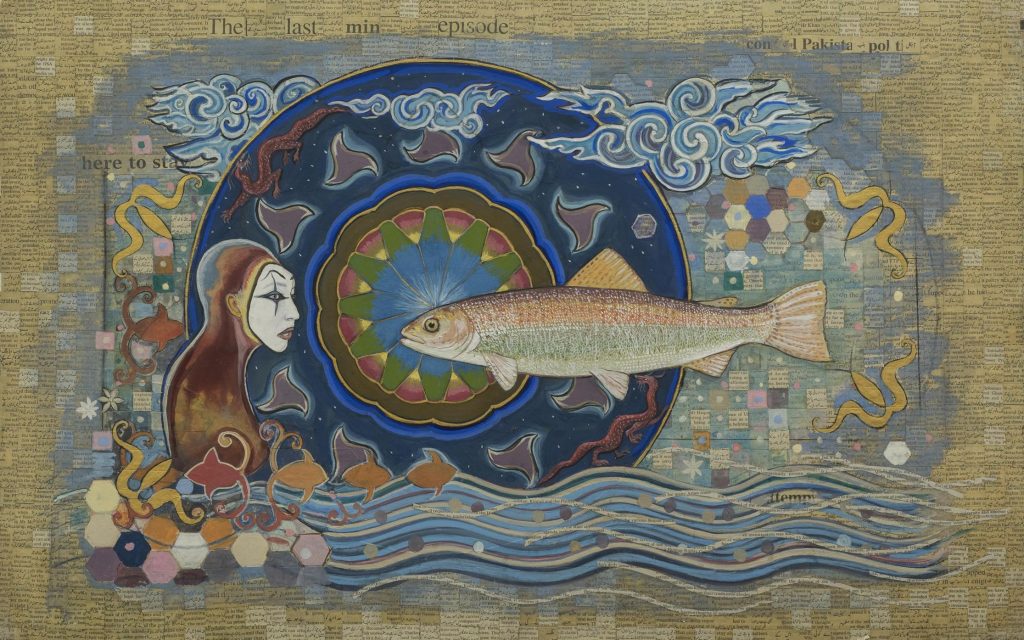
In the new works of Syeda Habib there are many links to tradition. But more than that, it is the idea of tradition that is evidently explored in the art of Syeda Habib. Drawing inspiration from sacred Islamic geometry, tantric motifs, Indian miniature painting and popular urban culture, she weaves a narrative that exists between fact and fiction, and beyond multiple identifications.
It is the composite imagery that distinguishes her new works from her earlier pieces, because now she is concentrating on a wider source of our society’s cultural and aesthetic milieu. Even though the current state of Pakistan is considered to be dominated by a unilateral community, heavily formed upon a singular religion and a uniform identity, but Habib questions and punctures these notions. In her work, one locates links to a variety of pictorial practices and pasts.
In fact past becomes a living present in the art of Syeda Habib. Since she explores its multiple versions, inquiring and comprehending present scenario. Hence past forms turn into metaphors – rather into issues, which are relevant in the present age. Situations of women, state of power, condition of ordinary citizens are a few aspects addressed in her work – albeit in an indirect and subtle manner.
One of the recurring imagery in the art of Syeda Habib is of composite human figures. Inspired from the miniatures of Krishna series, the work turns into a comment upon the plight of women in a society that is dominated by men, yet the mode of expression does not make her content into a slogan or a cause. Like an artist who is true to his/her medium of expression, her content is imbibed with its pictorial sensibility, thus these works depict the formal as well as conceptual concerns.
The artist’s political consciousness is apparent in a number of works, with dominant image of chair. In some works chair is connected through other seats of power through whirling lines. Although the silhouette of chair suggests its origin in the Indian miniature painting, but the way this form is placed, produced and presented, one can read the covert content/comment about the situation of power and political dominance in a society trying to find its way through the web or confusion of democracy and dictatorship.
Her politically charged imagery reappears with a family of three humans, composed against the newspaper page. This and other body of works in the same format allude to the way our society has become a victim of media, which not only provides information, but also controls how we perceive world (and ourselves too). Just as figures are situated on the lines of text in her work, human beings are also trapped in the web of information twenty-four hours round the year. In a sense media has overpowered our ideas, feelings, believes, styles and ways of living. This is a fate that is unavoidable, thus narrated in a sublime manner in the art of Syeda Habib.
But like any intelligent, diverse and diligent artist, Habib is reflecting on the social divide with a sensibility that verges on lyricism and fantastic. Joining wooden tools of masons, she creates a sculpture that reminds of formal solutions in art as well as some sort of weapon. Her socially conscious works at the same times are exercises in aesthetic possibilities, since on one level the three tools joined next to each other to become one object, can be a comment on the idea, practice and history of minimalism.
Syeda Habib extends the notion of minimalism into the realm of geometry and constructs images of complex nature, by developing compositions through adding basic shapes. Combining basic unites into works of optical nature; these works invoke diverse sensory associations; yet these also convey the artist’s approach towards tradition in the age of modernity. Motifs from traditional sources, art of twentieth century and popular visual culture converge into a pictorial presence that becomes a unifying feature in her new works. Works, which signify how an artist draws, collects and converts various visual elements to formulate a new vocabulary that is personal, poetic and pertinent – as it envisages a new layer, dimension and definition of reality, and of reality of art!
Quddus Mirza 2016
Source: Canvas Gallery
